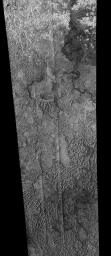
|
Flowing Liquids on Titan
- Click the image above for a larger view
- Full-Res JPEG (1536 x 3548) (1.5 MB)
- Full-Res TIFF (1536 x 3548) (5.5 MB)
Caption:
This synthetic aperture radar image was obtained by the Cassini spacecraft on its pass by Titan's south pole on Dec. 20, 2007. This image is centered near 76.5 south, 32.5 west and covers an area of 620 kilometers by 270 kilometers (385 miles by 170 miles).
Abundant evidence for flowing liquids is seen in this image, from sinuous, wide river channels to shorter, more chaotic drainage patterns. The extremely dissected, rugged terrain in the southern portion of the image has been very eroded by flowing liquids, probably from a combination of methane rainstorms and sapping (subsurface methane rising to erode the surface). The broad valleys seen in the southern portion of the image are particularly intriguing, as they appear to be flat-floored, filled with smooth material, and in places have sharply defined, relatively straight sides. Valleys such as this can be formed by tectonic processes, such as rifting, or by erosional processes, caused by flowing liquid or ice.
Background Info:
The Cassini-Huygens mission is a cooperative project of NASA, the European Space Agency and the Italian Space Agency. NASA's Jet Propulsion Laboratory, a division of the California Institute of Technology in Pasadena, manages the mission for NASA's Science Mission Directorate, Washington, D.C. The Cassini orbiter was designed, developed and assembled at JPL. The radar instrument was built by JPL and the Italian Space Agency, working with team members from the United States and several European countries.
For more information about the Cassini-Huygens mission, visit http://saturn.jpl.nasa.gov/home/index.cfm .
Cataloging Keywords:
| Name | Value | Additional Values |
|---|---|---|
| Target | Titan | |
| System | Saturn | |
| Target Type | Satellite | |
| Mission | Cassini-Huygens | |
| Instrument Host | Cassini Orbiter | |
| Host Type | Orbiter | |
| Instrument | Radar Mapper | |
| Detector | ||
| Extra Keywords | Atmosphere, Grayscale, Methane, Radar, Storm | |
| Acquisition Date | ||
| Release Date | 2008-01-08 | |
| Date in Caption | 2007-12-20 | |
| Image Credit | NASA/JPL-Caltech/ASI | |
| Source | photojournal.jpl.nasa.gov/catalog/PIA10219 | |
| Identifier | PIA10219 | |
